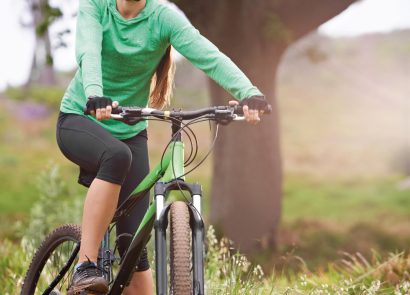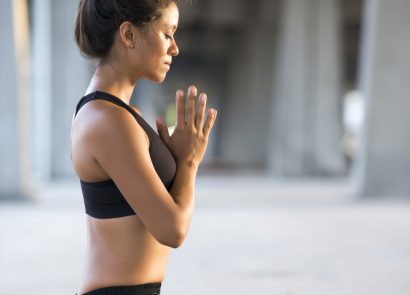Walking is one of the most accessible types of exercises out there – it’s free, you don’t need any equipment and it’s simple to find ways to add it to your day. Plus, studies show that the health benefits of walking long distances (or even just 20 minutes!) can reduce your risk of heart disease and improve your memory.
Let’s not forget about the social benefits of walking, too. Why not get together with a friend to catch up and increase your step count at the same time? Keen to know more? Walk with us!
What are the health benefits of walking?
Ever thought that walking wasn’t a valid workout? Our experts would say otherwise. Sometimes it’s easy to forget that all physical activity is exercise and, just like other activities that get you moving, walking also helps the body produce happy endorphins.
Ideal for those who are new to exercise, living with injuries, or perhaps not interested in vigorous exercise, a brisk walk can help transform a bad day into a good day by stimulating the production of serotonin – and as an added bonus, the benefits of brisk walking will also see a calorie burn of between 100-300 after around 30 minutes.
A walk will help you to maintain a healthy weight
Depending on your current weight and fitness level, you can burn approximately 200-400 calories per hour when doing your local walks, which quickly adds up. Walking also leads to greater sugar uptake by the muscle cells, which in turn regulates your blood glucose levels, keeps your blood-sugar levels stable and helps you burn fat more efficiently.
Walking will tone your entire lower body
Going for a walk is the ideal way to tone your thighs, hamstrings, glutes and calves. During walks, try to find a route with a hill to really work your hamstrings and glutes. Alternatively, why not try a walk off-road? The uneven terrain will not only improve your agility but also activate more muscles in the body, including your core – and the more muscle you have, the higher your basal metabolic rate, which means you burn more calories even at rest.
Walking is gentle on your joints
Walking is considered to be a low-impact exercise that’s accessible to almost everyone, no matter what age or fitness level. Low-impact exercise has a lower injury risk and is great for older people, so everyone can be consistent with their training, which is key when it comes to regular physical exercise.
A walk boosts your mental wellbeing
Ever wondered why you hold weight on your tummy despite all your hard work trying to exercise it off? It could be down to too much of the stress hormone cortisol, which causes the body to hold on to fat.
A good way to reduce these pesky stress hormones is by getting some fresh air and soaking up some natural vitamin D while walking – a great health benefit from being outside.
In fact, studies show that walking helps to improve your mood and may even ward off anxiety and depression, especially when you go strolling in a soothing environment such as a beach or park. So, if you’re feeling overwhelmed or bogged down, take a break, lace up your trainers and go for a walk.
Walking is good for the heart
Walking raises your heart rate and improves blood flow. It also strengthens the heart and lowers your blood pressure; all of which reduces the risk of coronary heart disease. A regular stroll can even lower your risk of diabetes and, amazingly, trigger an anti-aging effect, which can help repair old DNA and slow down the aging process!
The perfect nature walk
While vegging out on the sofa might seem appealing, the only antidote to a big Sunday roast is stretching your legs. Taking a walk after dinner can help lower blood sugar levels, improve digestion and put you in a good mood.
Equally, a morning walk before breakfast is bound to set you up for the day – there really isn’t one optimum time to walk, just whatever works well for you.
To inspire you, we’ve rounded up the best walks across the country. Wellies at the ready!
The best walks for the whole family
There’s nothing quite like getting everyone together for a walk, so why not head to Sheffield Park, just east of Haywards Heath in East Sussex. Choose whether you want to muddy your boots up by stomping across the woodland and park, or keep them clean by sticking to the path – whatever your preference, there’s a stroll to suit everyone.
A one and a half-mile circular walk takes you past Ringwood Toll natural playtrail (ideal for little ones with energy to spare), or you can explore even further by venturing down to the River Ouse.
Further afield, Mount Stewart in County Down, Northern Ireland, has plenty to offer. Voted as one of the top 10 gardens in the world, Mount Stewart’s formal gardens are full of character, complete with stories and facts about the families who lived here.
The best walks for nature lovers
For all budding bird watchers, wildlife is what makes a walk, and you won’t regret taking a stroll around the beautiful garden at Powis Castle in Welshpool. Look out for the shaped hedges and intricately trained fruit trees casting their long shadows in the low afternoon light.
Do you live nearer to Nottinghamshire? Then head to the Attenborough Nature Reserve in Beeston.
This easy four-mile walk around the glorious nature reserve showcases some of the best wildlife in the UK. The site was opened by Sir David Attenborough more than 40 years ago and remains a popular spot for nature-fanatics to stake out. Bring your binoculars and look out for birds such as goldeneyes and pochards.
The best walks for coastal lovers
Nothing quite beats a bracing coastal walk, so if you love the sea, then a stroll across Tŷ Coch, in Porthdinllaen, Wales, is a favourite for locals and those who are keen for walking holidays. Enjoy a spot of salty sea air to revive you, then venture to the famous Tŷ Coch Inn, which many Welsh residents argue is the best pub in Wales. Warm-up with tasty refreshments and live entertainment, all while taking in the glorious views of the wild Irish Sea.
If you often head over to the Norfolk coast, then don’t forget to take an amble around the seaside town of Sheringham. Striking coastal views are central to the design of Sheringham Park, and if you climb to the top of the gazebo tower perched at the summit of Oak Wood Hill, you can catch a panoramic view of the North Norfolk coast line.
Best walks for long hikes
Are you a seasoned walker? This Chilterns walk at the Ashridge Estate, Buckinghamshire is 14 miles-long and a perfect leg-stretcher. Worth saving for a day with clear skies and crisp ground under foot, walkers will be treated to expansive views of the countryside from the top of Ivinghoe Beacon, and even if the ancient trees have dropped their leaves, you’re still in with a good chance of spotting fallow deer.
In Jersey, the St Lawrence Parish Walk is an eight-mile hike that takes around three and half hours. The reward? A chance to discover the island’s most beautiful country lanes through the circular loop that boasts both the Hamptonne Museum and Jersey War Tunnels. Don’t forget to wrap up extra warm, as the wind can whip your cheeks.
Best routes for short ambles
If you’re eager to get outside, but not fond of a long hike, then a shorter stroll might suit you better, and nothing beats a forest walk, right? Erddig’s Big Wood trail is situated in Wrexham on the border of England and Wales. The short circular walk, full of kissing gates and towering oak trees, takes you around the orange waymarker route on the 1,200-acre estate. Follow the path that goes up to the bailey, where you cross an avenue of beech trees, before descending to the ditch of the 12th-century motte.
Closer to the south, with four way-marked walks to choose from, Basildon Park is a country house situated two miles south of Goring-on-Thames and Streatley in Berkshire, with half a mile to three-mile walks to choose from. Explore the estate by traipsing through the woodland and fields and take a glimpse through the bare trees to see the statuesque outline of the park’s mansion.
Best routes for dog walkers
Combining your stomp with a dog-friendly excursion is a win-win situation. Head to Langdale Valley, Cumbria and enjoy the countryside in all its glory on this two-mile walk. It’s a great opportunity for the family to get out into the fells safely, while enjoying brilliant views.
If you’re staying just outside of London, then head to Polesden Lacey, Surrey. This mildly challenging, but hugely rewarding three and a half mile walk takes approximately two hours. Stop at each viewpoint and look for the inspirational quote or extract of poetry – each has been chosen to complement the surrounding landscape.
The walking essentials to get you started
When it comes to walking, it’s no surprise that walking boots are going to be at the top of your list. These walking essentials from Decathlon provide the perfect kit to accompany you on those Peak District walks – or any other routes for that matter!
Decathlon walking shoes
These shoes provide comfort and protection for your feet, thanks to cushioning along the entire length of the sole, support for the high-top upper and a waterproof membrane to keep them dry. Looking for hi-tec walking boots? Go Outdoors has a great selection.
Trekking jacket
This RDS-certified down jacket keeps you warm during your treks in cool weather – down to -5°C during physical activity. Its fill power of 800 CUIN delivers very good warmth for its weight too.
Walking fleece
Perfect for when the weather is in that in-between stage of winter and spring, this fleece has been designed for those who enjoy hill walking. Lightweight with it’s microgrid component that provides very good breathability, it will protect you from the cold, but ensure you won’t overheat.
Walking aids
A walk in the park probably won’t require walking aids, such as trekking poles, but the benefits of walking sticks will help you to stay balanced on slippery surfaces and can also be good anchor points if you’re walking down a steep hill.
Hiker walking pole
The Hiker Walking Pole from Mountain Warehouse allows you to take on the mountain with ease, thanks to its durable, solid and anti-shock design. Ergonomically designed, this lightweight telescopic pole is an asset in any outdoor environment.
Anti-shock collapsible trekking pole
Equipped with baskets for enhanced stability on uneven terrain, the strong and lightweight aluminium shaft of the poles from Trespass have rubber stoppers for grip, and the adjustable fabric wrist straps keep the poles put, preventing loss and saving you from bending down to pick them up.
Can I lose weight by walking?
The short answer is yes, but it’ll take you longer to get to your goal than running every day, for example. Having said that, running is high impact and not so good for your joints. Plus, I bet you’d be more willing to step outside for a countryside ramble than a pounding-the-pavements gruelling run, right? We asked the experts how to use walking to help you meet your health goals.
Know the benefits of low intensity exercise
LISS, or low intensity steady state training, has been an underrated form of exercise for years. New research by Decathlon has revealed that 28 percent of Brits believe that a sweaty workout means you’re burning more fat, but that’s simply not true, according to consultant physiotherapist, Benjamin Coffey. “Many of us think that exercise must be hard and intense to be of any benefit, but walking certainly shouldn’t be underestimated as a good workout. The great thing about walking is that you can just open the front door and you’ll be doing it, without any stress or mental preparation. It’s also easier on the joints and tendons than running and it can even be a more effective way to lose weight.”
Include the elements of HIIT
So, we’ve established that walking is a legitimate form of exercise, but are there any pitfalls? “The issue with steady state exercise is that it requires a lot of time to achieve the same level of aerobic conditioning as you would expect from high intensity exercise,” explains Vicki Anstey, leading fitness figure and founder of Barreworks.
In other words, when comparing running to walking as a means of quicker weight loss, running would win hands down, due to the fact that you’re exerting more force and therefore using more energy, says Dr Flaminia Ronca, senior teaching fellow at the Institute of Sport, Exercise & Health (ISEH). “If you’re looking for cost-effectiveness of your time, you’ll want to run a mile [instead of walk it], but the truth is, most of us would rather not!” So, how can we improve our fitness, while being mindful of injuries and niggles?
“The most effective way of burning calories and increasing your cardiovascular health is using a combination of low and high bouts of intensity called interval training,” Dr Ronca recommends. Think: walking up inclines or adding some bodyweight exercises, such as squats and lunges, to your daily route.
The walking fat burning zone
Of course, there’s a big difference between going for a leisurely stroll and power walking with a weighted vest on, so how do we know if our walk is having a real effect on burning calories and torching fat?
“As long as you’re working around 55 to 70 percent of your maximum heart rate (or five to six on a scale of one to 10), you’ll be in the right zone to keep fuel consumption primarily to fat,” states Vicki. “By driving up the intensity [of your walk], you’ll boost your metabolism through post-exercise oxygen consumption and work your muscles, ligaments and cardiovascular health far more.”
Recovery is also an important factor when considering fat loss. As Benjamin explains, most people can walk for much longer than they can run, and more frequently too, without getting tired and needing to rest before they’re able to exercise again. “This means that someone who walks daily can burn close to the same amount of calories as someone who runs for less time, less often.”
This is how walking boosts your mental wellbeing
It’s not just the physical benefits that walking provides: our mental health gets a boost, too. As we know, the advantages to outdoor exercise are three-fold: reduced stress and anxiety, improved mood and a deeper connection to nature. “Simply being outside has a positive effect on your mental health,” says Dr Courtney Kipps, consultant in sport and exercise medicine at the Institute of Sport, Exercise & Health (ISEH). “Exercising outdoors magnifies these effects and is therefore ideal for relieving anxiety, stress and depression.”
Dr Flaminia echoes this, as she claims going for a walk is a sure-fire way to get your brain into action. “Research also shows that exercise can boost cognition; for example your creativity, memory and speed. So, if you need to figure out a new strategy for an upcoming project or prepare to study a new topic at work, take a walk before getting back to the books.”
How much walking do I need to do to lose weight?
If you have the time and desire, then a power walk over distance can be a great way to increase your fitness levels and get the head space we sometimes need.
Our experts have proved that walking really doesn’t get the credit it deserves, but to kick things up a notch, Vicki suggests doing high intensity activities alongside your daily hike for maximum results. “Our bodies will always use fat stores for fuel consumption when we’re resting, but we do need to try higher intensity activities every now and then to get a training effect and improve our overall fitness.”
However if you’re just starting out, walking is a great place to begin, advises Dr Courtney. “The important thing is to simply start and then you can build it up as your fitness increases. Set yourself sensible, specific and achievable short-term goals and then review them as you begin to tick them off.”
There you go: an activity that you don’t need any equipment for that provides you with mental and physical health benefits, and you can start right away. Ready to give it a try? We’ll be right behind you every step of the way.
Your walk planner: Take your walk to the next level
Wondering how to maximise your walk? Sam Gregory, head trainer at F45 Stratford shares his tips to help give it a leg up.
Turn your walk into a circuit class
“Set a timer and for every two minutes, stop and do 20 squats, 20 lunges and 20 star jumps. This will definitely add an extra level of intensity to your walk.”
Try this walking workout
“HIIT training [high intensity interval training] is a great way of improving your fitness, as well as burning body fat and building lean muscle. So, start with five minutes of brisk walking, sprint for 20 seconds and walk slowly for one minute and 40 seconds. Repeat this eight times and finish with a five-minute slow walk to recover.”
Include hill walking
“The benefits of walking uphill are two-fold: not only will this have a great knock-on effect for how energised you will feel after your walk, but you should also find it easier to maintain a faster walk than before, as long as you are not picking a flat route!”
Get some headspace
“Walking is a great way to switch off from the stress and strain that these unprecedented times can cause. Use the time for you via a meditation app or, even better, leave the phone at home and focus on the beauty that can be found all around us. Every time your mind drifts back to your stress, reset and focus on the walk.”
Give yourself some active rest
“It’s important to get adequate rest and recovery. Keep it slow, focus on your breathing and even incorporate some nice, low-level stretches along the way. Your body will definitely thank you, as it enables you to work towards a measurable and obtainable target.”
Download a free walking app to track your progress
Okay, so you know the benefits, you’ve got the gear, now if you’re keen to get really serious about walking, a walking app can help you to answer questions such as ‘how far have I walked?’ and ‘how long does it take to walk five miles?’. They can also track your speed, distance and act as a pedometer if you’re aiming for those 10,000 steps in your walking routine. Here are the best to download now.
Map My Walk
Discover new routes wherever you are with Map My Walk, and load your saved favourites. Start challenges with friends and push your crew to set new goals.
ARGUS by Azumio
From steps to sleep, this app tracks just about everything. You can gather all your data that allows you to understand the bigger trends in your life.
Calories calculator
If you’re keen to find out the number of calories burned while walking, this calculator from Bupa enables you to work out how many calories you’ve expended using your weight, the activity you completed and the duration of that activity.





















